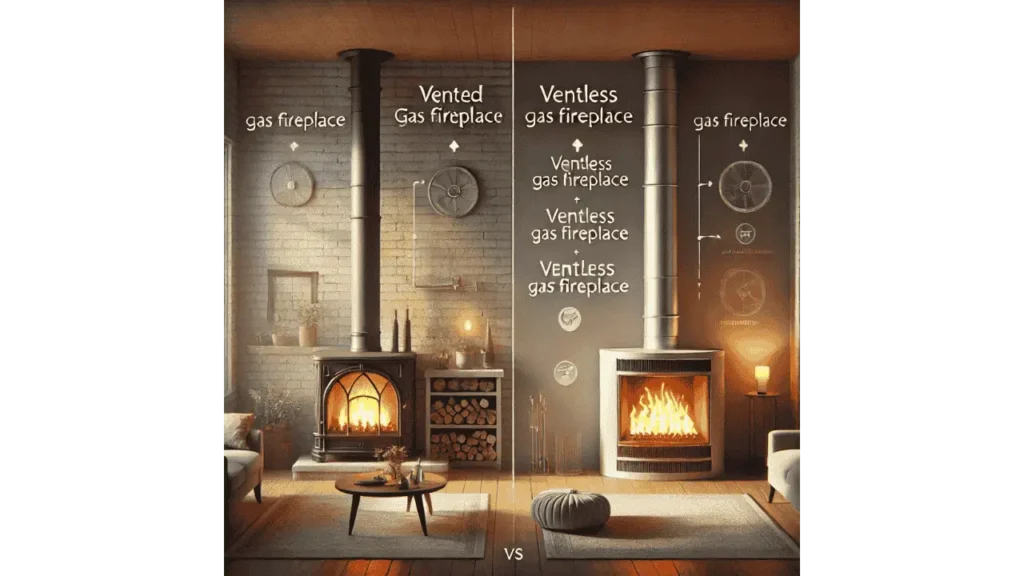The short answer: not always! It depends on the type of gas fireplace you have. Vented gas fireplaces, like direct vent and natural vent models, require a chimney or vent to expel fumes outside. However, vent-free gas fireplaces don’t need a chimney at all, they’re designed to burn cleanly, producing minimal emissions that are safe to stay indoors. So, while some gas fireplaces do need a chimney, others are completely ventless, offering flexibility depending on your home’s setup.
Do Gas Fireplaces Require a Chimney?
While many gas fireplaces require some form of ventilation, not all need a traditional chimney. Direct vent systems and natural vent fireplaces use vents or flues to move air in and exhaust gasses out. Meanwhile, vent-free models are designed to burn cleanly without needing a chimney. Let’s dive into the different types of ventilation options for gas fireplaces.
Direct Ventilation for Gas Fireplaces
Direct vent fireplaces use pipes to pull in outside air for combustion and expel gasses out. This is the most common type of gas fireplace ventilation, and it’s what I have at home. It’s efficient, doesn’t require a full chimney, and keeps indoor air clean.
Natural Ventilation
Natural vent (or B-vent) fireplaces rely on a chimney or flue to remove gasses. They’re similar to traditional wood or stone fireplaces, drawing air from inside the home and venting it through the roof. It’s an option if you prefer a more classic setup.
Power Vents
Power vent systems use a fan to help push exhaust gasses outside. They’re ideal for setups where traditional venting is difficult. If your home’s layout doesn’t allow for standard venting, power vents give you more flexibility.
Vent-Free
Vent-free gas fireplaces don’t need a chimney or vent. These models are super convenient and can be installed almost anywhere. They’re designed to burn cleanly, though it’s important to ensure proper air circulation for safety.
Learn More: How to Easily Light a Gas Fireplace?
Cleaning & Maintenance For Gas Fireplaces
Even if your gas fireplace doesn’t need a chimney, regular cleaning and maintenance are still important to keep it running smoothly and safely. Let’s go over some quick tips.
Brush Away Dust and Dirt
Over time, dust can accumulate inside your fireplace, especially around the burner. Use a soft brush or vacuum attachment to clean the area gently, preventing buildup that could affect performance.
Clean Out The Cobwebs
Cobwebs can easily collect inside and around the fireplace vents, especially if it’s not in use regularly. A quick check and clean with a vacuum or duster keeps airflow clear and the fireplace functioning properly.
Clean the Glass
Over time, the glass doors on your fireplace can fog up or get dirty. Use a glass cleaner designed for fireplaces to wipe away smudges, ensuring you can enjoy a clear view of the flames.
Examine Your Vents
For vented gas fireplaces, check your vents or flue to ensure they’re free from blockages or damage. Regularly inspecting them ensures proper ventilation and safety while your fireplace is in use.
Final Takeaways
Whether or not a gas fireplace needs a chimney depends on its venting system. While vented models require some form of ventilation, vent-free options don’t need a chimney at all. Regular maintenance, like cleaning dust and checking vents, ensures your fireplace runs safely and efficiently. With the right care, your gas fireplace will keep your home warm and cozy for years to come!
- 27 Farmhouse Fireplace Ideas That Bring Warmth & Charm - August 18, 2025
- 25 Fireplace Lighting Ideas to Illuminate Your Hearth - August 7, 2025
- How to Replace an Electric Fireplace Switch? - August 5, 2025



